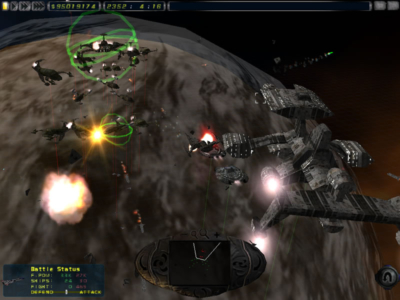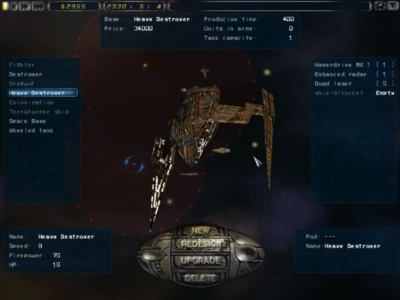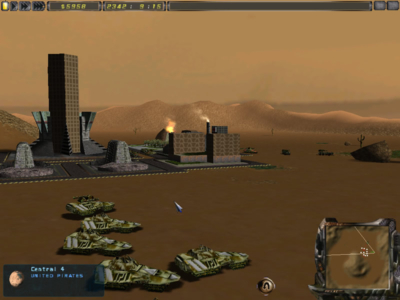
Imperium Galactica 2
Written by: Stoo
Date posted: December 13, 2004
- Genre: Strategy
- Developed by: Digital Reality
- Published by: Infrogames
- Year released: 2000
- Our score: 7
Released in 1997, the original Imperium Galactica was a strategy title of the subgenre known as ‘4X’. Nothing to do with Australian lager, this stands for eXplore, eXpand, eXploit, eXterminate. It’s all about galactic conquest; starting from a single world you must colonise new planets, build up a fleet of mighty warships, research new technologies for your colonies and ships, and defeat your rival empires. Your ultimate aim: complete domination of your patch of space. It’s the idea pioneered by Sid Meier’s Civilisation many years ago, but on an interstellar scale.
With IG, Hungarian Developers Digital Reality made an attempt to do something a little different from the empire-building norm. Namely, they eschewed the usual turn-based nature of these games for real-time gameplay, and also seemed to take their cues for different aspects of the game from other popular titles, plundering ideas from Command and Conquer and Simcity. The end result was reasonably well-received by critics, even if it didn’ quite set the strategy gaming world alight. I played it a bit, years back and found it quite enjoyable enough, if somewhat fiddly.
A few years later, Digital Reality had another go, so once again it’s time to send out your fleets and conquer the galaxy. The game hinges primarily around 3 main races: firstly there’s warmongering Kra’en who are singularly uninterested in diplomacy and simply trample and over-run everyone in sight. The shifty Shinari meanwhile are supposed to be bit weak militarily, but prefer the backstabbing path to success and are excellent at diplomacy and espionage. Finally the Solarians (humans) gain an edge from their skills at researching fancy new technologies. They even seem to have something of a storyline attached, though it is a bit half-baked. There are another half-dozen races or so inhabiting the galaxy but you can’t play as them yourself in the main campaign, just in shorter scenarios or multiplayer.
After choosing your race, and watching a fairly decent (if not really essential to the proceedings) pre-rendered cutscene, you are presented with the game itself. As is usual for a 4X game, this is based around a starmap. From here you can view and select your colonies and fleets. Although the map lies in a 2d plane, it’s rendered in quite pleasing 3D, with lots of twinkling lights etc, while chilled ambient music plays in the background. While aesthetic appeal is hardly the most vital component of these games, attention to such things is still always welcome. From here you can select the speed at which time passes, so if all is quiet and your factories are busily working away, you can set it to fastest and let the various processes take place. Or you can slow or pause time if you want to fiddle with a colony or deal with an invading fleet.
Colony management is where the game goes a bit SimCity on us. Most importantly for your empire, you of course need to build factories and research centres, but there’s a whole host of extra structures required to keep the colony in business. Nothing will even operate in the first place without power plants, and you also need houses, food factories, police stations, hospitals and recreational facilities to keep your population happy. Some defensive forts and gun emplacements might come on handy, too. Finally, trading ports can generate you income from the AI-controlled merchants who constantly travel around the starmap. Again it’s all in 3D; not especially flashy or advanced but it’s still quite fun panning over your growing cities.
Of course, in these games resource management is punctuated with the inevitable clashes of mighty space fleets. First you need to design and build yo warships; unfortunately there’s not a huge amount of choice here. If you read the Master of Orion 2 or Ascendancy reviews, you’ll note I’m a big fan of being able to design ships from scratch, and decide for myself how much space to allocate to various components. With IG2 however there are a number of pre-determined slots for lasers, shields, radar etc, – with more slots on the larger ship classes. Thus the design process is for the most part a case of just sticking the most advanced version of each component into its slot. You do get a few choices here and there, but nothing like the wealth of options in Moo2.
Combat itself is again real-time, played out in the familiar Command-and-Conquer style. However; it’s not a particularly tactical affair, so really don’t go expecting a bout of Homeworld. Your input once the action starts is usually of little consequence; it’s just a slugfest with the obvious advantage in numbers, unless you possess significantly superior technology. The ships line up and let rip with their cannon and torpedoes, fighters swarm around distracting and wearing down the big guns, and a minute or so later it’s all over. Your ships might have one or two special functions (like a paralysing attack) that you can try and use on the best available targets, but for the most part you’re really just sitting back and enjoying the fireworks.
Ground battles are a similar sort of affair. To be fair though, most other 4X games tend to regard this as a fairly minor feature and make little effort, so IG2 actually ends up doing a bit better than its peers. For one thing the size of the arena of play is somewhat larger relative to the units taking part than in space battles, so there’s more scope for manoeuvring around the battlefield, launching pincer attacks, dividing the enemy and concentrating your fire and so on. Note there’s not a lot of choice in unit types and no infantry; just tanks. For the most part they hammer at each other with various sized canon, although you can build minelayers too, as well as units that call down laser strikes from orbiting ships.
Now, even if that forth X is for exterminate, it should be remembered that there is still supposed to be more to dealing with your rivals than just blowing ’em up. Unless you’re playing as the Kra’Hen anyway, who really are dedicated to pure warfare. For a more underhanded means of debilitating your foes, IG2 features quite a comprehensive spying system. You can send agents to gather information on empires, steal technologies, sabotage warships and so on. Or you can keep them home for training, or working defensively on counter-intelligence. With time their skills grow, chance of success in a mission rises and further more ambitious mission types arise. Even if you don’t want to make widespread use of this feature, most of your enemies will. So it’s a good idea to at least keep a couple of spies working defensively.
Meanwhile you can also try just talking to the other empires. At the most basic level you can trysending compliments or insults, oe offering a gift of money in persuading your rivals to co-operate. Once on friendly terms with a particular race, you can suggest technology exchanges and non-aggression pacts, or go one step further and attempt to arrange alliances. The idea being that when a massive alien fleet comes knocking on your door you can yell for help, tho the downside is your allies might themselves make such a request of you. It seems quite a well-featured diplomacy system, though in practice though I found the AI empires to be quite obstinate, ignoring friendly overtures and often declaring war for no apparent reason. Well, you would expect some races to be overtly aggressive in a game like this, but some should be friendlier too.
I should say at this point, I still find this game pretty damn challenging. The ‘easy’ setting lives up to its name, as you start off with some major advantages compared to the other empires, but on ‘normal’ I’ve lost more games than won. I don’t know if I’m just being inept, but I can normally beat games like this on their mid-level settings. The difficulty I find is simply in keeping up with the AI empires in terms of shipbuilding. Even the Shinari, who are specifically described as militarily weak, seem to put some impressive arsenals together sometimes. It’s especially problematic when dealing with the Kra’Hen; not only can you not communicate with them via the diplomacy screen, but it also seems impossible to send spies to hamper their efforts. Every single session of this game comes down to an inevitable showdown with the Monstrous Kra’Hen Megafleet, providing no-one else squashes you first, as they always seem to defeat any other AI empires they encounter before confronting your own.
Of course, I’d expect an epic battle or two to often form the climax of a 4X game, it just gets annoying when it comes down to the same damn hard battle, every time. Especially given the nature of combat here. Whoever is bigger and badder wins… and that’s usually the Kra’Hen. So every run through becomes a frantic shipbuilding spree, with just about any action balanced against the question of how much it will hinder churning out that fleet.
So overall IG2 is obviously a little frustrating at times, and it certainly takes perseverance even by 4X standards, but determined strategy-heads should find it worthwhile eventually. Resource and colony management is quite well-handled (especially if you’re not after vast levels of fiddly detail), and the game functions pretty well in most other aspects also. Watching your fleets rumble though enemy territory is entertaining as ever, providing you can up an economy and production base to provide this with the required speed. It still looks better than much of the competition, and some great music helps maintain a sense of atmosphere. Even if you normally find 4x games (or their earth-based cousins) a bit slow and staid, perhaps the real-time nature of this one will provide an extra attraction.





 Posts
Posts